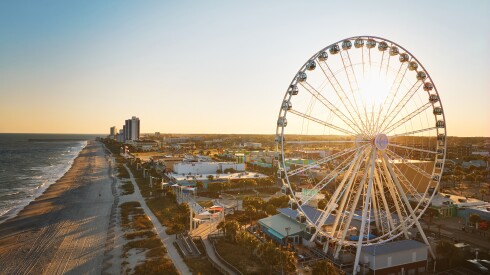Growing up in New Mexico, I was weaned on green chile. We ate it not only in enchiladas and burritos, but also in eggs, on cheeseburgers, on pizza, and in pasta Alfredo. When I visited the state last summer, I tasted a dark chocolate–green chile truffle, dined with a local restaurateur whose roast beef sandwich bulged with more chile than meat, and met a pastry chef who was developing peach–green chile sorbet. Green chile—and it’s always spelled that way and referred to as such, thought of more as a flavor than as an individual pepper—is part of the state’s cultural identity. And it’s an obsession among Land of Enchantment expats like me.
“There aren’t many places where you can sample a cuisine with a long tradition that hasn’t been watered down,” food historian and cookbook author Cheryl Jamison said over a lunch of green chile enchiladas at The Shed restaurant in Santa Fe during my visit. Jamison grew up in Illinois and moved to New Mexico, decades ago, because the food fascinated her. “This area was so isolated from the rest of the United States, they had to use what was here,” she said. Spanish colonists brought chile to the region—along with pork and chicken—and added it to the indigenous staples of blue corn, beans, and squash. “You had to use chile or there was no seasoning.” Other places have beans, corn, and meat; it’s the chile that distinguishes New Mexican food. “It wasn’t added as a finishing touch . . . but was a core component of a meal,” Jamison wrote in her 2012 cookbook, Tasting New Mexico.
Green chile—thought of more as a flavor than as an individual pepper—is part of the state’s cultural identity.
Today’s green chile was first bred in the late 19th century by researchers at the New Mexico College of Agriculture and Mechanic Arts. The flavor comes not only from the plant but also from New Mexico’s hot, dry growing conditions; when the same seeds were grown in lower-stress California, they became Anaheim chiles—much more timid, heat-wise.
The New Mexican green chile (also known as the Hatch chile, because most are grown near the town of Hatch, in the southern part of the state) is milder than its relatives the jalapeño and the poblano, and roasting brings out its inherent smokiness. It’s not eating contest stuff. More typically, Hatch chiles have a pleasingly slow burn and some sinus-clearing effects, but they let you taste the other flavors in your food.
Hatch’s annual Labor Day weekend chile festival draws as many as 30,000 people to the town of 1,600, but Santa Fe is where green chile cuisine blossoms. At The Shed, a cornerstone of the city’s dining scene, you can order tacos, burritos, enchiladas, chowders, stews, and calabacitas (sautéed squash) that all incorporate the full-bodied green chile. “When I was growing up, we learned how to cook green chile from our neighbors,” said Shed co-owner Courtney Carswell, who joined Jamison and me for lunch. “When you eat in homes, you get the best sampling of a cuisine.” As he talked, I took a bite of the Shed’s famous enchiladas. The hand-ground blue corn tortillas provided perfect ballast to the smoky meatiness of the green chile and salty richness of the Monterey Jack cheese. And with that bite, I knew I was back home.

Photo by Jen Judge
How to Make Green Chile Chicken Enchiladas
(SERVES 6)
Based on a recipe from the Shed
Green Chile Sauce
Ingredients
- 5 pounds fresh or frozen New Mexico (Hatch) green chile, roasted, peeled, and diced (a combination of poblano and jalapeño chile can be substituted)
- 6 cloves garlic, chopped
- 5 cups water
- 2 tbsp shortening
- 2 tbsp flour
- 1 tsp salt, or to taste
Make it
- In a blender, in batches, cover chile and garlic with water and blend until smooth.
- In a 2-quart saucepan, heat the shortening until it is liquid.
- Add a pinch of flour to the shortening, which will cause it to bubble.
- Add the remaining flour and stir until you have a golden brown roux.
- Whisk the chile mixture into the roux.
- Add salt to taste and simmer for one hour, stirring occasionally, adding water to achieve a thick but pourable sauce.
Enchiladas
Ingredients
- 1 cup shortening or canola oil
- 12 blue or yellow corn tortillas
- 2 pounds chicken, light and dark meat, roasted and shredded
- 1 1/2 pounds Monterey Jack cheese, grated
- 1/2 cup green onion, minced
- 8 cups green chile sauce (one batch, above)
Make it
- Heat the shortening or oil in a frying pan
- Fry the tortillas in oil just enough to soften, then blot with paper towels
- On an ovenproof plate, place one tortilla and top it with 1 cup of chicken, 4 ounces of cheese, and 1 1/4 tbsp onion
- Cover this with another tortilla, sprinkle with more cheese, and cover this “flat” enchilada with 1/6 of the green chile sauce
- Repeat with the remaining ingredients on five more plates
- Bake in a pre-heated oven at 450° until sauce and cheese begin to bubble.
This article originally appeared online in 2013; it was updated in January 2018 to include current information.











